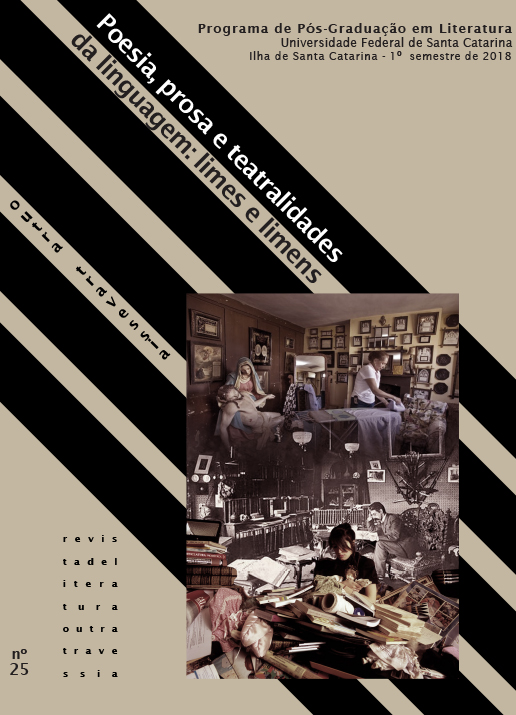O espaço liso e o diagrama aberto: A topologia poética de André Vallias
DOI:
https://doi.org/10.5007/2176-8552.2018n25p71Resumen
Segundo Roman Jakobson, a poesia estabelece sua qualidade diferencial por estar dotada de uma configuração (patterning) verbal subliminar – uma tessitura paralelística que ocasiona a justaposição de “figuras de gramática” e “figuras de som”. Esta padronagem verbal daria uma espécie de "esqueleto abstrato" ao corpo do poema. Quando, na semiose, a metalinguagem implica-se como material integrante do signo, o ato criativo acaba por se confundir com ela – os paralelismos entre linguagem e metalinguagem passam a gerar figuras de figuras, o "esqueleto" vira do avesso e faz proliferar imagens ou diagramas de similaridade. Movimentos desta magnitude costumam originar saltos criativos; é a partir de um destes saltos que André Vallias inaugura um novo espaço de imaginação poética. Na seqüência de poemas desta fase (em especial Nous n’avons pas compris Descartes e de verso), o universo intervalado da textura alfabética e das distribuições rítmicas ganha um ponto de contato com o universo contínuo das imagens: diagramas rítmicos, representantes in abstracto das oscilações de intensidade entre as sílabas, tornam-se eles mesmos poemas. É tal captura crítica que, a partir dos conceitos de "espaço liso" e "diagrama aberto", intentamos analisar, pensando em como Vallias transforma a imaginação fonética da página numa imaginação topológica.
Citas
AZEREDO CAMPOS, Roland de. Sobre “Nous n’avons pas compris Descartes”. Disponível em: http://www.andrevallias.com/textos/txt01.htm. Acesso em: 9. nov 2017.
BENSE, Max. Pequena Estética. 2. ed. Tradução de Haroldo de Campos. São Paulo: Perspectiva, 1975.
BOULEZ, Pierre. A música hoje. 3. ed. Tradução de Reginaldo de Carvalho e Mary Amazonas Leite de Barros. São Paulo: Perspectiva, 2016.
BOULEZ, Pierre. Inteligência Brasileira. Tradução de Tércio Redondo. São Paulo: Cosac Naify, 2009.
DELEUZE, Gilles; GUATTARI, Félix. Mil Platôs. v. 5, 2. ed. Tradução de Ana Lúcia de Oliveira e Lúcia Cláudia Leão. São Paulo: Editora 34, 2012.
FLUSSER, Vilém. A escrita. Tradução de Murilo Jardelino da Costa. São Paulo: Anna Blume, 2010.
FLUSSER, Vilém. Filosofia da caixa preta: ensaios para uma futura filosofia da fotografia. Rio de Janeiro: Relume Dumará, 2002.
JAKOBSON, Roman. Linguística. Poética. Cinema. Tradução de Tradução Haroldo de Campos. 2. ed. São Paulo: Perspectiva, 2004.
JAKOBSON, Roman. Poética em ação. Tradução de João Alexandre Barbosa. São Paulo: Perspectiva, 1990.
PEIRCE, Charles Sanders. Semiótica. Tradução de Jose Teixeira Coelho Neto. São Paulo: Perspectiva, 2010.
PIGNATARI, Décio. O que é comunicação poética. 10. ed. São Paulo: Ateliê Editorial, 2011.
PIGNATARI, Décio. Semiótica da arte e da arquitetura. 4. ed. São Paulo: Ateliê Editorial, 2009.
PIGNATARI, Décio. Semiótica & Literatura. São Paulo: Ateliê Editorial, 2004.
VALÉRY, Paul. Introdução ao método de Leonardo da Vinci. Tradução de Geraldo Gerson de Souza. São Paulo: Editora 34, 1998.
VALÉRY, Paul. Variedades. Tradução de Maiza Martins de Siqueira. São Paulo: Iluminuras, 2007.
VALLIAS, André. De verso. Disponível em: http://www.andrevallias.com/deverso/deverso.htm. Acesso em: 9 nov. 2017.
VALLIAS, André. Nous n’avons pas compris Descartes. Disponível em: http://www.andrevallias.com/poemas/nous.htm. Acesso em: 9 nov. 2017.
VALLIAS, André. Oratorio. Disponível em: http://www.andrevallias.com/oratorio/. Acesso em: 9 nov. 2017.
VALLIAS, André. Trakltakt. Disponível em: http://www.andrevallias.com/trakltakt/. Acesso em: 9 nov. 2017.
WALTHER-BENSE, Elisabeth. A Teoria geral dos signos. Tradução de Perola de Carvalho. São Paulo: Perspectiva, 2010.
ZDEBIK, Jakub. Deleuze and the diagram: Aesthetic Threads in Visual Organization. London: Continuum, 2012.
Descargas
Publicado
Número
Sección
Licencia
Os artigos e demais trabalhos publicados na outra travessia passam a ser propriedade da revista. Uma nova publicação do mesmo texto, de iniciativa de seu autor ou de terceiros, fica sujeita à expressa menção da precedência de sua publicação neste periódico, citando-se a edição e data dessa publicação.
Esta obra foi licenciada com uma Licença Creative Commons Atribuição-NãoComercial 4.0 Internacional.



